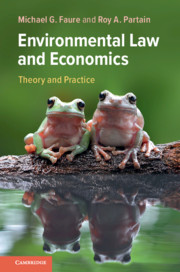Book contents
- Environmental Law and Economics
- Environmental Law and Economics
- Copyright page
- Contents
- Preface
- Acknowledgements
- Abbreviations
- 1 Introduction
- 2 Environmental Harm and Efficiency
- 3 Property Rights Approach to Environmental Law
- 4 Environmental Standard Setting
- 5 Principles of Environmental Law and Environmental Economics
- 6 Pricing Environmental Harm
- 7 Market-Based Instruments
- 8 Liability Rules
- 9 Environmental Regulation
- 10 Environmental Crime
- 11 Insurance for Environmental Damage
- 12 Compensation for Environmental Damage
- 13 Environmental Federalism
- 14 The Role of Environmental Law in Developing Countries
- 15 Epilogue
- References
- Index
4 - Environmental Standard Setting
Published online by Cambridge University Press: 13 September 2019
- Environmental Law and Economics
- Environmental Law and Economics
- Copyright page
- Contents
- Preface
- Acknowledgements
- Abbreviations
- 1 Introduction
- 2 Environmental Harm and Efficiency
- 3 Property Rights Approach to Environmental Law
- 4 Environmental Standard Setting
- 5 Principles of Environmental Law and Environmental Economics
- 6 Pricing Environmental Harm
- 7 Market-Based Instruments
- 8 Liability Rules
- 9 Environmental Regulation
- 10 Environmental Crime
- 11 Insurance for Environmental Damage
- 12 Compensation for Environmental Damage
- 13 Environmental Federalism
- 14 The Role of Environmental Law in Developing Countries
- 15 Epilogue
- References
- Index
Summary
This chapter on standard setting began by exploring the differences between legal and economic notions of standards and what standard setting means in both research disciplines. We then further clarified the legal concept for environmental law, wherein we set out three forms of standards to be set: (i) target standards, such as or ambient quality standards; (ii) emission standards, and (iii) production or specification standards. We then discussed optimal standard setting and we reviewed cultural relativity, that different cultural communities might place various environmental goals in different priorities. Standard setting is clearly at the heart of environmental law -- to set environmental goals, predicated on community preferences, to better achieve desired levels of environmental welfare or services. But the task of standard setting is both as complex as the set of environmental challenges facing a community as it is complicated by the particular goals desired in diverse communities. Standard setting is then also a question of ‘environmental federalism; the guidelines for setting standards for local injuries and global injuries might differ substantially.
Keywords
- Type
- Chapter
- Information
- Environmental Law and EconomicsTheory and Practice, pp. 63 - 78Publisher: Cambridge University PressPrint publication year: 2019
- 1
- Cited by



